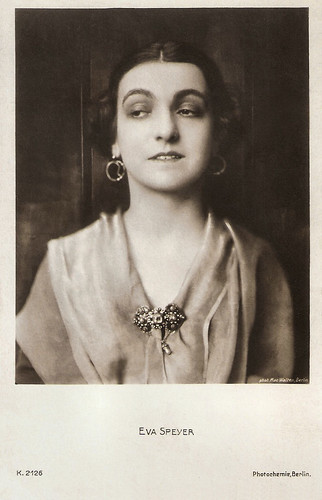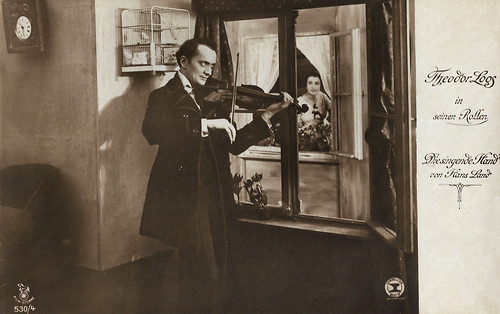
German postcard by Photochemie, Berlin, no. K. 229. Photo: W. Bernhardt, Chbg.

German postcard by Photochemie, Berlin, no. K. 1861. Photo: Alex Binder, Berlin.

German postcard. Photo: Alex Binder.

German postcard by Photochemie, Berlin no. K. 2126. Photo: Mac Walten, Berlin.
Suffering women in short melodramas
Eva Speyer was born Eva Esther Speier in 1883 in Berlin, Germany. She was the daughter of the stockbroker Fedor Speier and his wife, the milliner Wilhelmine, née Mahn.
Eva received her training as an actress at the Marie Seebach School and made her debut in Hirschberg in 1904. In 1905 she appeared in Posen and from 1906 to 1908 at the Schauspielhaus Düsseldorf. In 1908 she embarked for America and appeared on stage in Milwaukee and in 1909 in New York.
In November 1910 she returned to Germany and played at Berlin stages such as the Lessingtheater, Trianon-Theater, and the Kleines Theater. She got in touch with the film business by chance. During an engagement at the Lessingtheater, she was asked by Paul Otto to play in the silent film Nora (1911).
The new medium film was becoming commercially successful in Germany. Thomas Staedeli at Cyranos: "She viewed the new medium as a welcome extra income without artistic challenge. When the technological basis improved considerably she changed her attitude to the film and saw the possibility to make the art accessible to the audience in an easy way."
In the next years, Speyer developed into one of the first stars of the German silent cinema. She played suffering women in such short melodramas as Die gelbe Rasse/The yellow breed (Max Mack, 1912), Dämonen der Tiefe/Demons of the Deep (Harry Piel, 1912), and Zwischen Himmel und Erde/'Tween Heaven and Earth (Otto Rippert, 1913) with Ernst Rückert.
During World War I, Eva starred in films like Der Geisterseher/The Ghost Seer (Waldemar Hecker, 1915), Der Talismann/The Talisman (Eddie Seefeld, 1915), Die Flucht des Arno Jessen/The Flight of Arno Jessen (Richard Eichberg, 1917) starring Ernst Rückert, and Es werde Licht! 2. Teil/Let there be light. Part 2 (Richard Oswald, 1918).
Spyer also played the female lead in the silent Science-Fiction film Die Arche/The Ark (Richard Oswald, 1919) starring Leo Connard. This is a two-part German epic about a near future in which civilisation has been destroyed.

German postcard by Rotophot in the Film-Sterne series, no. 530/1. Photo: Amboß-Film Dworsky & Co. Theodor Loos and Eva Speyer in Die singende Hand (Arthur Wellin, 1918). Hans Land was the pseudonym of Hugo Landsberger, who scripted the film.

German postcard by Rotophot in the Film-Sterne series, no. 530/3. Photo: Amboß-Film Dworsky & Co. Theodor Loos as the violin player Leonid Heller in Die singende Hand (Arthur Wellin, 1918). The woman on the ground is Eva Speyer as Esther. The man left of Loos is Otto Gebühr, playing the Duke of Gralby.

German postcard by Rotophot in the Film-Sterne series, no. 530/4. Photo: Amboß-Film Dworsky & Co. Theodor Loos in Die singende Hand (Arthur Wellin, 1918). The woman is Eva Speyer.
A character actress in many well-known films
From the 1920s onwards, Eva Speyer's days as a star were over but she proved her talent as a character actress in many well-known films. These included § 182 minderjährig/Paragraph 182 (Ernst Winar, 1927) starring Colette Brettel, Dirnentragödie/Tragedy of the Street (Bruno Rahn, 1927) starring Asta Nielsen, and Unter der Laterne/Under the Lantern (Gerhard Lamprecht, 1928) starring Lissy Arna.
In the drama Jugendtragödie/Tragedy of Youth (Adolf Trotz, 1929), she played a washerwoman, whose son (Roland Varno) is sent to a reform school for a minor crime. He breaks out and commits a murder.
During the sound era, Speyer appeared in three more films, Namensheirat/Marriage in Name Only (Heinz Paul, 1930) with Evelyn Holt, the comedy Ich bleib bei Dir/I stay with you (Johannes Meyer, 1932), and the drugs drama Der weisse Dämon/The White Demon (Kurt Gerron, 1932) starring Hans Albers.
Speyer was initially married to the actor Otto Stöckl and was therefore also known as Eva Speyer-Stöckl. In 1918, she wed merchant Robert Ebert in her second marriage. About what happened to her after 1932, the sources differ.
According to German Wikipedia, she was completely excluded from public culture because of her Jewish descent after the National Socialists came to power in 1933 and probably emigrated a short time later.
However, Italian Wikipedia quotes IMDb that indicates that the actress died in 1932 at the age of 50. Where is unknown. Filmportal.de confirms this date.

German postcard in the Film Sterne Series by Rotophot, no. 188/2. Photo: Becker & Maass.

German postcard by Photochemie, Berlin, no. K. 227. Photo: W. Bernhardt, Chbg.

German postcard by Photochemie, Berlin, no. K. 230. Photo: W. Bernhardt, Chbg.

German postcard by Verlag Herm. Leiser, Berlin-Wilm., no. 1653. Photo: Willinger.
Sources: Thomas Staedeli (Cyranos), Filmportal.de, Wikipedia (English, German and Italian), and IMDb.
No comments:
Post a Comment